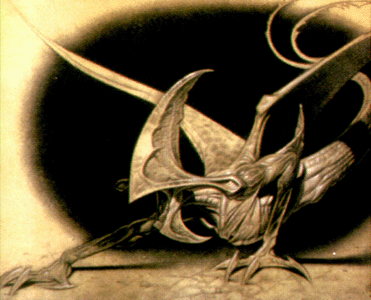Night Stalkers

Like many of the creatures that are found in the ruined wasteland, the origin of this particular creature is thought to be off-world. Some speculate that they are from an alternate dimension, as they share similar vulnerabilities to light, which is similar to these other creatures. No one knows for certain.
Although very insectoid appearing, the Night Stalker creature shares many similarities to both mammals and insects.
Chris Van Deelen is the author of the Skirmisher Publishing LLC sourcebook Creatures of the Tropical Wastes sourcebook, co-author of its Wisdom from the Wastelands game supplement and contributor to the 'Sword of Kos: Hekaton' Anthology.
No. Enc: 1d4
Alignment: Neutral
Movement: 90' (30')
210’ (70’) Fly
AC: 1
HD: 10
Attacks: 1 bite or 2 claws or 1 tail slap
Damage: 2d6 or 2d8 / 2d8 or 3d6
Save: L10
Morale: 11
Hoard Class: None
Like many of the creatures that are found in the ruined wasteland, the origin of this particular creature is thought to be off-world. Some speculate that they are from an alternate dimension, as they share similar vulnerabilities to light, which is similar to these other creatures. No one knows for certain.
Although very insectoid appearing, the Night Stalker creature shares many similarities to both mammals and insects.
First of all, these monsters are massive. They are almost twenty feet from the tip of their bony head to the base of their long double ended tail. The wing span is almost forty feet in length as well. They are incredibly heavy as well, easily weighing in excess of 500 pounds, which gives speculation to the fact that they might possess some sort of psionic ability to help them stay aloft. When they are not flying, the Night Stalkers move about on two powerful forelegs. These legs end in claws that have four blade sharp claws.
These creatures are pure predators. They only hunt at night or in areas where there is no light present. The reason is because are very vulnerable to ultraviolet radiation and even if they are exposed to it for mere seconds, they could very well be killed by it. If the creatures are hit with weapons using Ultraviolet radiation they must save versus energy attacks or be killed instantly. Even if they save, they lose half of their remaining hit points outright.
They are never found above ground except at night. The rest of the time, they spend the days sleeping deep in the bowels of the earth, always found in mountain ranges (with plenty of caves), ruins or similar locations where it is easy for them to escape the sun.
They have never displayed any sort of intelligence above that of animals, and have no use what so ever for treasure or technology, although there is the occasional trinket or item that can be found in their lairs, the tokens of the creatures they have consumed over the years.
When they hunt, the creatures produce a very unique cry, which is a form of echolocation, although they can see perfectly well in the dark. Creatures that live in the territory of these monsters know that when they hear that sound, they have mere minutes, at best, to find a suitable hiding spot or they become the Night Stalkers next meal.
When engaged in combat, the creature has several methods at hand to help it dispatch an enemy or make quick work of its next meal. It can bite or rend a target with its talons, or it can use its whip like tail. More often than not it will attempt to employ its tail first, as any target it hits with the tail must make a save versus stun or be knocked prone on top of taking the damage from the sharp spines that jut from the two sections of tail.
Any creature that is knocked to the ground will be pounced upon, with the hunter gaining a +4 to hit with its bit or claw attacks.
As previously mentioned, the creature shares traits derived from two entirely different species. It is warm-blooded, but has a very tough exoskeleton, much like that of an insect, and appears to have a hive mind like that of an insect.
The creature has two separate sexes, and it reproduces through mating. The females lay clutches of 1d100 eggs three months after successful intercourse with a male. The eggs are always kept in the deepest part of their lairs, keeping them clear of any potential sources of ultraviolet radiation.
After six months the eggs hatch and the young go into a frenzy, spreading out of the lair no matter the time of day to hunt for food. It is because of this reason that the world hasn’t been over-run by the creatures, as the vast majority of the young are incinerated by the sun’s UV rays.
Those who survive this first day learn from the mistakes of their siblings and stay underground during the daylight hours, venturing out only at night to feed and find suitable locations to set up their own nests. The young mature quickly, reaching adult size (depending on the quantity of food in their particular locals) in 24 months.
Mutations: complete wing development, echolocation, epidermal susceptibility (ultraviolet light), natural armour, night vision, thermal vision.
Source: Pitch Black (2000)




